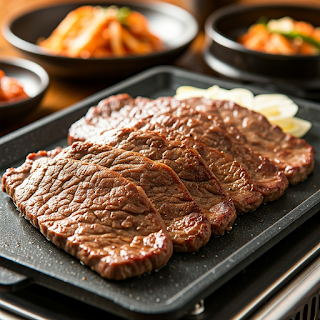Table of Contents
Introduction
Wishing you a wonderful day! Are you ready to explore the vibrant flavors of Korean cuisine? If you love discovering new dishes from around the world, you are going to fall in love with the diverse and exciting world of K-food.
Today, I would like to share with you the Top 10 Korean Dishes Every Foodie Must Try. These are dishes I personally enjoy and recommend to anyone visiting Korea. I will also include some of my personal experiences to make this guide more fun and relatable. Let's dive in!
1. Kimchi
Kimchi is perhaps the most iconic Korean dish. This fermented vegetable dish, usually made with napa cabbage and radish, is seasoned with chili powder, garlic, ginger, and other spices.
I remember the first time I introduced kimchi to my American friend. She hesitated at first, but after one bite, she was hooked! Now, she always asks me where to buy good kimchi in her city.
| Ingredient | Main Flavor | Health Benefits |
|---|---|---|
| Napa cabbage | Spicy, tangy | Rich in probiotics and vitamins |
| Radish | Crisp, slightly sweet | Boosts digestion |
2. Bibimbap
Bibimbap literally means "mixed rice." It consists of warm rice topped with sautéed and seasoned vegetables, a fried egg, sliced meat, and gochujang (Korean chili paste).
Whenever I visit a new Korean restaurant, I always try their bibimbap first to see how creative they are with the ingredients. Have you ever tried mixing everything together and enjoying the burst of flavors in every bite?
3. Bulgogi
Bulgogi, which means "fire meat," is thinly sliced marinated beef grilled on a barbecue or stovetop. The marinade typically includes soy sauce, sugar, sesame oil, garlic, and pepper.
My most memorable bulgogi experience was during a family gathering. We grilled bulgogi on a portable barbecue right at the dining table—so delicious and so much fun!
| Meat Type | Cooking Method | Popular Occasion |
|---|---|---|
| Beef (ribeye, sirloin) | Grilled or pan-fried | Family gatherings, celebrations |
4. Tteokbokki
Tteokbokki is a beloved Korean street food made of chewy rice cakes simmered in a spicy-sweet gochujang sauce. It's often topped with fish cakes, boiled eggs, and scallions.
I often grab a plate of tteokbokki from a street vendor on a cold winter day—it instantly warms you up and brings a smile to your face.
5. Samgyeopsal
Samgyeopsal is thick slices of pork belly grilled at the table. The fun part is wrapping the meat in lettuce leaves along with garlic, ssamjang (spicy paste), and various condiments.
If you visit Korea, don't miss the chance to enjoy samgyeopsal with locals—it's a highly social and interactive dining experience. When was the last time you grilled your own meal?
6. Galbijjim
Galbijjim is braised short ribs cooked in a rich, savory-sweet sauce with vegetables like carrots and potatoes. The meat is so tender that it falls off the bone.
I love preparing galbijjim for holiday dinners. It never fails to impress guests with its deep flavors and melt-in-your-mouth texture.
| Main Ingredient | Cooking Time | Flavor Profile |
|---|---|---|
| Beef short ribs | 2-3 hours | Savory, sweet, umami-rich |
7. Japchae
Japchae is a dish made of glass noodles stir-fried with vegetables and sometimes beef. The noodles, made from sweet potato starch, are chewy and have a wonderful texture.
I once prepared japchae for a potluck party, and it was the first dish to disappear from the table! It's colorful, flavorful, and a true crowd-pleaser.
8. Sundubu-jjigae
Sundubu-jjigae is a spicy soft tofu stew with vegetables, seafood or meat, and an egg cracked on top. It's served boiling hot in a stone pot.
I love ordering sundubu-jjigae on rainy days—it’s comforting and soul-warming. Have you ever tried eating it with a bowl of freshly steamed rice?
9. Jeon
Jeon refers to a variety of Korean pancakes made by pan-frying battered ingredients such as seafood, kimchi, or vegetables.
During Korean holidays, I help my mom prepare several types of jeon. It’s a labor of love, and gathering around the kitchen while cooking is always a cherished memory.
10. Samgyetang
Samgyetang is a traditional Korean ginseng chicken soup. A whole young chicken is stuffed with glutinous rice, garlic, and jujubes, then simmered in a rich broth.
Koreans often enjoy samgyetang during the hottest days of summer to restore energy. Personally, I find it incredibly nourishing after a long hike or a busy week.
FAQ
Q1. Are these dishes spicy?
A1. Some, like kimchi and sundubu-jjigae, can be spicy, but the level of heat can often be adjusted to your preference.
Q2. Is Korean food suitable for vegetarians?
A2. Yes, many Korean dishes can be adapted for vegetarians, such as japchae and various types of jeon.
Q3. Where can I try authentic Korean food?
A3. The best place is of course Korea, but many major cities worldwide now have excellent Korean restaurants.
Q4. What is a good dish to start with for beginners?
A4. Bibimbap is a great choice—it’s mild, customizable, and a perfect introduction to Korean flavors.
Final Thoughts
Thank you so much for reading this guide to the top 10 Korean dishes! I hope you found it helpful and inspiring. Exploring a country's food is one of the best ways to experience its culture, and I truly believe Korean cuisine has so much to offer.
If you get the chance to visit Korea—or even just a good Korean restaurant in your city—I encourage you to try these dishes. Who knows? You might just discover a new favorite.
Thanks again for stopping by, and happy eating!











